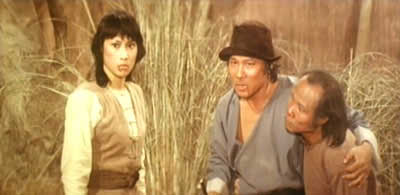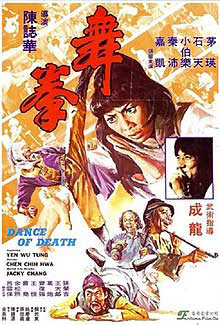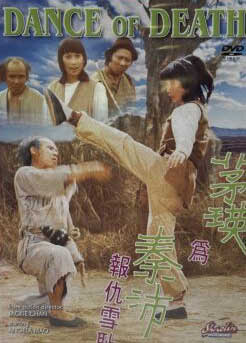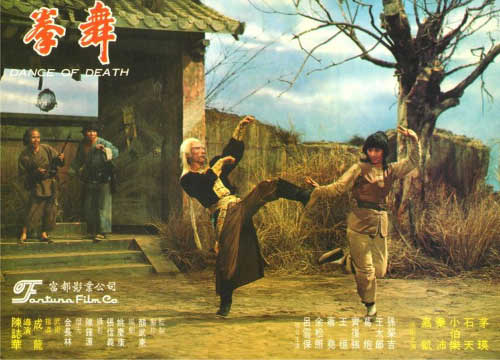Dance of Death
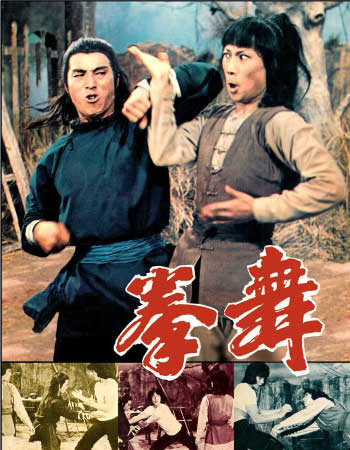
Director: Chen Chi-hwa
Year: 1979
Rating: 7.0
For the
most part this Angela Mao film is played for laughs and it is a bit goofier
than I would have preferred. The kung-fu comedy was very popular at the time
and though I can’t think of any another one of her films that indulges in
this genre, everyone was doing it. Seeing Angela making strange faces, monkey
sounds and general silliness never quite sets right with me. But there is
a lot of fighting and mugging and much of it is well-choreographed.
Another kung fu school kills a few of Angela Mao’s friends, but she is able
to escape. She comes upon an Abbot and Costello kung fu country bumpkin pair
who fight each other every five years to see who has the best kung fu. This
has been going on for 20-years. Fortunately, they always fight to a draw,
but Angela – dressed as a man - tricks them into training her so that they
can see who is better by watching her fight her opponents. Her real motive
is of course revenge. The two goof balls are played by Hsu Pu-liao and
Wang Tai-lang. One likes the pipe and other the bottle and while fighting
they take many breaks to enjoy both. Oddly, it was the pipe smoker Hsu Pu-liao
who died in real life from alcoholism.
Then the film flashes backwards. Three men from the Hundred Bird School
are attacking Ku Cheng-wan (Paul Chun-pui) and getting the best of him when
Angela comes out of the bushes to the whistling tune of The Good, The Bad
and The Ugly dressed in a poncho, a basket hat and a straw between her lips.
A silly but well-choreographed fight then takes place where she makes fun
of them as much as fights them. They go back to their Master all battered
and bruised and the Master calls out Bird Egg to go after Ku. If you didn't
already know you were watching a kung-fu comedy before, you do now because
Bird Egg is played by Dean Shek - one of the masters of the kung-fu comedy
genre. He immediately goes into a routine and if you dislike this specific
genre you may want to bail out but then there is Angela. He is as annoying
as ever but he actually beats her in a fight using all sorts of defenses.
The film suddenly takes a serious turn when some of the Hundred Bird School
show up at the school that have taken in Angela and Ku and kill them all
except for Angela who escapes. This brings us back to the beginning
of the film.
After a short training period - which I appreciated - training sequences
are fine up to a point but get tiresome if they go on for too long - Angela
takes her show on the road. She tracks down and challenges the men from the
Hundred Bird School with her two teachers tagging along keeping track of whose
moves she uses. First it is the three Birds from before, then she takes on
Egg Bird and defeats him this time - his major weapon seems to be farting
- it is again a fight that you can't take seriously as at one time the Pink
Panther tune breaks in. It is frustrating to watch because by this time you
want it to get serious again. I mean this is Angela Mao - we want the glare
and the kill shot. But then it does get more interesting as she takes on the
head of the Hundred Bird School and a bunch of his minions. This is more like
it. Then a stop at a bordello to look for another one of the men who killed
her friends. The girl she selects keeps asking her to take off her clothes
and enjoy herself. How can you have fun with your clothes on? Even at the
end it is never revealed that Angela is a woman. Maybe she was in fact playing
a man.
Of course, Angela has to take on the white haired killer of her friends,
Mu Fa-shan played by Chia Kai. I am not entirely sure where the figure of
the white haired kung fu killer came from. Usually adorned with bushy white
eye-brows as well, he is almost always the best most deadly fighter in the
film. Usually a villain and it often takes a group of good guys to bring him
down. When did this figure first appear I wonder - in film or in books? And
does it originate with a real historical figure - Bak Mei (White Eyebrow)
who was one of the Five Elders of the Shaolin Temple and is reputed by some
sources to have betrayed it which would explain his villain status. Anyway,
Angela has to use all her moves from monkey fu to dance-fu to defeat him.
Jackie Chan choreographed the fights - unusual for him to do it for films
he was not in. The choreography was too light-hearted for my taste - even
the final one - but even so it is hard not to admire and respect the wonderful
timing and acrobatics necessary. Lots of flips, somersaults, form exercises
and about every style you can think of – always announced. It was a pleasure
watching the amazing agility and grace of Angela Mao. In the opening credits,
she performs a solo exercise that wonderfully showcases her disciplined and
perfect movement. I think this was her last major role. HKMDB lists another
ten films after this but I have heard of none of them and I expect that her
role was small to a cameo but I would like to see them just in case she has
a good role.


